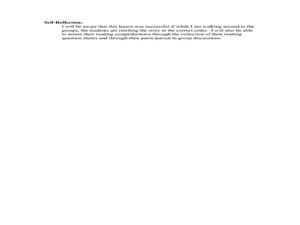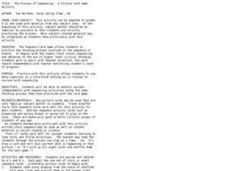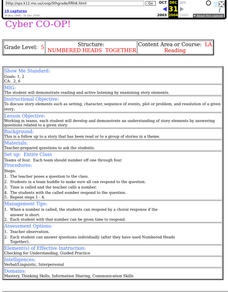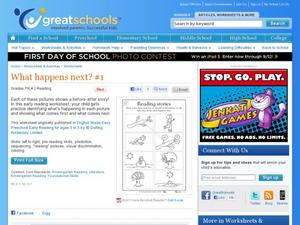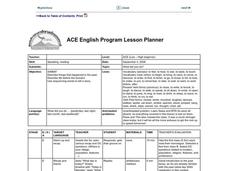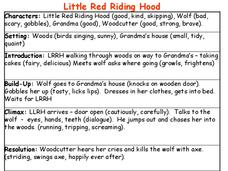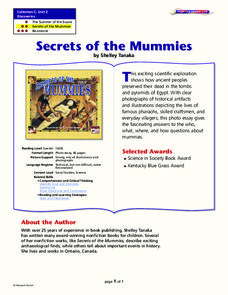Curated OER
Story Sequencing Strips
For this story sequence worksheet, students cut out the sequence strips and write what happens in their story in the order they occur. Students link them together to form a chain.
Curated OER
The Very Hungry Caterpillar: A Sequencing Lesson
Students listen to "The Very Hungry Caterpillar" and summarize to story to demonstrate comprehension. They review the days of the week and create their own book.
Curated OER
The Little Hungry Caterpillar
Students discuss "The Little Hungry Caterpillar." In this reading comprehension lesson plan, students make sock caterpillars used in retelling the story so as sequence the events accurately.
Curated OER
Life Cycles: A Never-Ending Story
Second graders describe the sequence of events in the life cycles of a butterfly, frog, and a deer. They observe the differences and similarities of parents and babies. They also discover that at different stages the animals can be...
Curated OER
Insects
It's a fact: kids love bugs! With this lesson, young learners explore reading informational texts and conducting research while learning about their favorite insects. Spark learners' interest by reading a book about one kind of bug and...
Curated OER
Time: Attribute
Students participate in five teacher-led, whole class activities that explore sequences of time and the concept of faster and slower. They sequence school day events, create a book of their daily schedule, put the days of the week in...
Curated OER
Zoom! Zoom! Zoom! I'm Off to the Moon Sequencing Lesson
Students practice sequencing. In this sequencing lesson, students listen to the book Zoom! Zoom! Zoom! I'm Off to the Moon. They put the story events in sequential order using a graphic organizer.
Curated OER
Sequence and Retell - The Napping House
Students sequence the story The Napping House by keeping trace of the characters in order. In this sequencing lesson plan, students also retell the story as they sequence.
Curated OER
The Process of Sequencing- A Picture Card Game Activity
Students put the events of a story in the correct order. In this sequencing lesson, students are paired up and labeled A or B. Students in each group receive a set of story or event sequence cards and they take turns drawing from the...
Curated OER
Comprehension: Understanding "sequence"
Second graders read the story The Broken Bed and then sequence the story in their own words. In this sequencing lesson plan, 2nd graders also write narrative with a specific beginning, middle, and end.
Curated OER
"The Story of Ruby Bridges"
Third graders examine the role of Ruby Bridges in the U.S. Civil Rights Movement. They listen to the teacher read the book "The Story of Ruby Bridges" by Robert Coles, identify what is fact or opinion in the story, and sequence events in...
Curated OER
The Process of Sequencing - A Picture Card Game
Students play a picture card game where they have to sequence the pictures in the correct order. For this sequencing lesson plan, students can do this for any subject.
Curated OER
Numbered Heads Together
Fifth graders demonstrate reading and active listening by examining story elements. Working in teams, each student will develop and demonstrate an understanding of story elements by answering questions related to a given story.
Curated OER
A Soldier's View of the American Civil War
Study and research the American Civil War in this explanatory writing lesson. Middle schoolers complete six activities to learn about the American Civil War and soldiers' views of the war. The lesson includes several options to complete...
Curated OER
Civil Rights Video Essay
Students research an event or a person from a decade in American history when the civil rights movement was an important focus. They create a multimedia project based on the research.
Curated OER
What Happens Next? 1
Knowing how to sequence events means you have to know what happens before and after. Little ones draw a line from four before images to the images that show what happened next. This is a good challenge for your youngest learners.
Curated OER
What Did You Do?
English learners practice using the past tense by participating in a time description activity. They identify the differences between verbs when they are used to describe current events or past events. Students answer questions using...
Curated OER
The Ultimate Survivor Using Hatchet by Gary Paulsen
What items would you need to survive if you were stranded in a remote place? Using chapter 10 of Gary Paulsen's Hatchet, middle-schoolers work through a Six Trait writing activity to create a story about their own survival in a similar...
Curated OER
Little Red Riding Hood
Here is a short, but effective, four-slide presentation on the sequence of events in the story, Little Red Riding Hood. The elements of the story (setting, characters, plot, etc.) are present, then a slide which puts the story in order...
Curated OER
Accordion Fold Book
You can use these basic instructions to create a book using the accordion fold. This project can be used alongside nearly any other instructional activity. Have kids fold a book to create a science journal, chapter-by-chapter book...
Curated OER
My First Biography: Christopher Columbus Storia Teaching Guide | Scholastic.com
Sail with Christopher Columbus on a biographical reading adventure. Young explorers learn about the life of Sir Columbus as they hone their comprehension skills through guiding questions, shared reading, and fluency practice. Included in...
Curated OER
Red Dirt Groundbreakers
Discover Oklahoma's first farmers. Read about 14 different agriculture workers and their contribution to Oklahoma's farming. After reading, have your class complete several activities such as researching an agriculturist, writing a...
Curated OER
Secrets of the Mummies
How did the ancient people of Egypt preserve their dead so well that their bodies are still recognizable today? Learn the painstakingly complex process they used for preservation. Young scholars read and summarize a narrative detailing...
Curated OER
Bearstone: A Novel Analysis
Seventh graders need to be able to distinguish between major and minor characters and need to have read the novel Bearstone and be familiar with the sequence of events as well as the qualities displayed by each character over the course...




